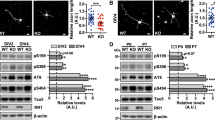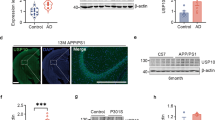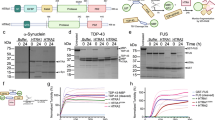Abstract
One of the neuropathological hallmarks of Alzheimer's disease is the neurofibrillary tangle, which contains paired helical filaments (PHFs) composed of the microtubule-associated protein tau1,2. Tau is hyperphosphorylated in PHFs3,4,5,, and phosphorylation of tau abolishes its ability to bind microtubules and promote microtubule assembly6,7. Restoring the function of phosphorylated tau might prevent or reverse PHF formation in Alzheimer's disease. Phosphorylation on a serine or threonine that precedes proline (pS/T–P) alters the rate of prolyl isomerization and creates a binding site for the WW domain of the prolyl isomerase Pin1 (refs 8,9,10,11, 12,13,14). Pin1 specifically isomerizes pS/T–P bonds and regulates the function of mitotic phosphoproteins8,9,10,12. Here we show that Pin1 binds to only one pT–P motif in tau and co-purifies with PHFs, resulting in depletion of soluble Pin1 in the brains of Alzheimer's disease patients. Pin1 can restore the ability of phosphorylated tau to bind microtubules and promote microtubule assembly in vitro. As depletion of Pin1 induces mitotic arrest and apoptotic cell death8, sequestration of Pin1 into PHFs may contribute to neuronal death. These findings provide a new insight into the pathogenesis of Alzheimer's disease.
This is a preview of subscription content, access via your institution
Access options
Subscribe to this journal
Receive 51 print issues and online access
$199.00 per year
only $3.90 per issue
Buy this article
- Purchase on Springer Link
- Instant access to full article PDF
Prices may be subject to local taxes which are calculated during checkout





Similar content being viewed by others
References
Kosik, K. S., Qiu, W. Q. & Greenberg, S. Cellular signaling pathways and cytoskeletal organization. Ann. NY Acad. Sci. 777, 114– 120 (1996).
Spillantini, M. G. & Goedert, M. Tau protein pathology in neurodegenerative diseases. Trends Neurosci. 21, 428–433 (1998).
Lee, V. M., Balin, B. J., Otvos, L. J & Trojanowski, J. Q. A68: a major subunit of paired helical filaments and derivatized forms of normal Tau. Science 251, 675– 678 (1991).
Goedert, M., Spillantini, M. G., Cairns, N. J. & Crowther, R. A. Tau proteins of Alzheimer paired helical filaments: abnormal phosphorylation of all six brain isoforms. Neuron. 8, 159 –168 (1992).
Greenberg, S. G., Davies, P., Schein, J. D. & Binder, L. I. Hydrofluoric acid-treated tau PPHF proteins display the same biochemical properties as normal tau. J. Biol. Chem. 267, 564– 569 (1992).
Bramblett, G. T. et al. Abnormal tau phosphorylation at Ser396 in Alzheimer's disease recapitulates development and contributes to reduced microtubule binding. Neuron 10, 1089–1099 (1993).
Yoshida, H. & Ihara, Y. Tau in paired helical filaments is functionally distinct from fetal tau: assembly incompetence of paired helical filament-tau. J. Neurochem. 61, 1183– 1186 (1993).
Lu, K. P., Hanes, S. D. & Hunter, T. Ahuman peptidyl-prolyl isomerase essential for regulation of mitosis. Nature 380, 544– 547 (1996).
Ranganathan, R., Lu, K. P., Hunter, T. & Noel, J. P. Structural and functional analysis of the mitotic peptidyl-prolyl isomerase Pin1 suggests that substrate recognition is phosphorylation dependent. Cell 89, 875–886 (1997).
Yaffe, M. B. et al. Sequence-specific and phosphorylation-dependent proline isomerization: A potential mitotic regulatory mechanism. Science 278 , 1957–1960 (1997).
Schutkowski, M. et al. Role of phosphorylation in determining the backbone dynamics of the serine/threonine-proline motif and Pin1 substrate recognition. Biochemistry 37, 5566–5575 (1998).
Shen, M., Stukenberg, P. T., Kirschner, M. W. & Lu, K. P. The essential mitotic peptidyl-prolyl isomerase Pin1 binds and regulates mitosis-specific phosphoproteins. Genes Dev. 12, 706– 720 (1998).
Lu, P. J., Zhou, X. Z., Shen, M. & Lu, K. P. Function of WW domains as phosphoserine or phosphothreonine-binding modules. Science 283, 1325–1328 (1999).
Lu, K. P. Phosphorylation-dependent prolyl isomerization: a novel cell cycle regulatory mechanism. Prog. Cell Cycle Res.(in the press).
Crenshaw, D. G., Yang, J., Means, A. R. & Kornbluth, S. The mitotic peptidyl-prolyl isomerase, Pin1, interacts with Cdc25 and Plx1. EMBO J. 17, 1315–1327 ( 1998).
Illenberger, S. et al. The endogenous and cell cycle-dependent phosphorylation of tau protein in living cells: implications for Alzheimer's disease. Mol. Biol. Cell 9, 1495–1512 (1998).
Vincent, I., Rosado, M. & Davies, P. Mitotic mechanisms in Alzheimer's disease? J. Cell Biol. 132, 413–425 (1996).
Vincent, I., Jicha, G., Rosado, M. & Dickson, D. W. Aberrant expression of mitotic cdc2/cyclin B1 kinase in degenerating neurons of Alzheimer's disease brain. J. Neurosci. 17, 3588– 3598 (1997).
Nagy, Z., Esiri, M. M. & Smith, A. D. Expression of cell division markers in the hippocampus in Alzheimer's disease and other neurodegenerative conditions. Acta Neuropathol. (Berl.) 93, 294– 300 (1997).
Kondratick, C. M. & Vandre, D. D. Alzheimer's disease neurofibrillary tangles contain mitosis-specific phosphoepitopes. J. Neurochem. 67, 2405– 2416 (1996).
Preuss, U. & Mandelkow, E. M. Mitotic phosphorylation of tau protein in neuronal cell lines resembles phosphorylation in Alzheimer's disease. Eur. J. Cell Biol. 76, 176– 184 (1998).
Vincent, I. J. & Davies, P. Aprotein kinase associated with paired helical filaments in Alzheimer disease. Proc. Natl Acad. Sci. USA 89, 2878– 2882 (1992).
Jicha, G. A. et al. Aconformation- and phosphorylation-dependent antibody recognizing the paired helical filaments of Alzheimer's disease. J. Neurochem. 69, 2087–2095 ( 1997).
Hutton, M. et al. Association of missense and 5′-splice-site mutations in tau with the inherited dementia FTDP-17. Nature 393, 702–705 (1998).
Clark, L. N. et al. Pathogenic implications of mutations in the tau gene in palido-ponto-nigral degeneration and related neurodegenerative disorders linked to chromosome 17. Proc. Natl Acad. Sci. USA 95, 13103– 13107 (1998).
Spillantini, M. G. et al. Mutation in the tau gene in familial multiple system tauopathy with presenile dementia. Proc. Natl Acad. Sci. USA 95, 7737–7741 (1998).
Iqbal, K., Zaidi, T., Bancher, C. & Grundke-Iqbal, I. Alzheimer paired helical filaments. Restoration of the biological activity by dephosphorylation. FEBS Lett. 349, 104–108 (1994).
Alonso, A. C., Zaidi, T., Grundke-Iqbal, I. & Iqbal, K. Role of abnormally phosphorylated tau in the breakdown of microtubules in Alzheimer disease. Proc. Natl Acad. Sci. USA 91, 5562–5566 (1994).
Spillantini, M. G., Bird, T. D. & Ghetti, B. Frontotemporal dementia and Parkinsonism linked to chromosome 17: a new group of tauopathies. Brain Pathol. 8, 387–402 (1998).
Hong, M. et al. Mutation-specific functional impairments in distinct tau isoforms of hereditary FTDP-17. Science 282, 1914 –1917 (1998).
Acknowledgements
We thank B. Neel, L. Cantley, C. S. Chen, G. Lee and X. D. Fu for constructive comments. P.-J.L. and G.W. are fellows of Leukemia Society of America and DOE Breast Cancer Research Program, respectively. K.P.L. is a Pew Scholar and a Leukemia Society of America Scholar. This study was supported by NIH grants to P.D. and K.P.L.
Author information
Authors and Affiliations
Corresponding author
Rights and permissions
About this article
Cite this article
Lu, PJ., Wulf, G., Zhou, X. et al. The prolyl isomerase Pin1 restores the function of Alzheimer-associated phosphorylated tau protein. Nature 399, 784–788 (1999). https://doi.org/10.1038/21650
Received:
Accepted:
Issue Date:
DOI: https://doi.org/10.1038/21650
This article is cited by
-
Death-associated protein kinase 1 as a therapeutic target for Alzheimer's disease
Translational Neurodegeneration (2024)
-
Long-term normalization of calcineurin activity in model mice rescues Pin1 and attenuates Alzheimer’s phenotypes without blocking peripheral T cell IL-2 response
Alzheimer's Research & Therapy (2023)
-
Tau protein binds to the P53 E3 ubiquitin ligase MDM2
Scientific Reports (2023)
-
Cis P-tau is a central circulating and placental etiologic driver and therapeutic target of preeclampsia
Nature Communications (2023)
-
The US9-Derived Protein gPTB9TM Modulates APP Processing Without Targeting Secretase Activities
Molecular Neurobiology (2023)
Comments
By submitting a comment you agree to abide by our Terms and Community Guidelines. If you find something abusive or that does not comply with our terms or guidelines please flag it as inappropriate.



